
The purpose of this task is to assess a student's ability to explain the meaning of independence in a simple context.
- Provider:
- Illustrative Mathematics
- Date Added:
- 06/22/2022

The purpose of this task is to assess a student's ability to explain the meaning of independence in a simple context.

The purpose of this task is to assess a student's ability to explain the meaning of independence in a simple context.
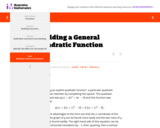
This task is for instructional purposes only and builds on ''Building an explicit quadratic function.'' First, it is vital that students have worked through ''Building an explicit quadratic function'' before undertaking this task.
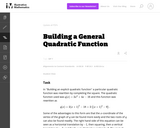
This task is for instructional purposes only and builds on ``Building an explicit quadratic function.''
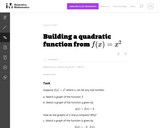
This is the first of a series of task aiming at understanding the quadratic formula in a geometric way in terms of the graph of a quadratic function.

This task applies reflections to a regular hexagon to construct a pattern of six hexagons enclosing a seventh: the focus of the task is on using the properties of reflections to deduce this seven hexagon pattern.

This task applies reflections to a regular octagon to construct a pattern of four octagons enclosing a quadrilateral: the focus of the task is on using the properties of reflections to deduce that the quadrilateral is actually a square.
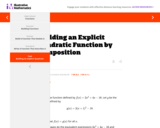
This task is intended for instruction and to motivate the task Building a General Quadratic Function. This task assumes that the students are familiar with the process of completing the square.

This task is intended for instruction and to motivate "Building a general quadratic function.''
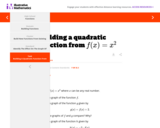
This is the first of a series of tasks aiming at understanding the quadratic formula in a geometric way in terms of the graph of a quadratic function. Here the student works with an explicit function and studies the impact of scaling and linear change of variables.
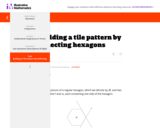
This task applies reflections to a regular hexagon to construct a pattern of six hexagons enclosing a seventh: the focus of the task is on using the properties of reflections to deduce this seven hexagon pattern.
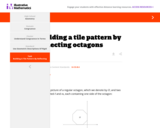
This task applies reflections to a regular octagon to construct a pattern of four octagons enclosing a quadrilateral: the focus of the task is on using the properties of reflections to deduce that the quadrilateral is actually a square.

In this task students determine the number of hundreds, tens and ones that are necessary to write equations when some digits are provided. Students must, in some cases, decompose hundreds to tens and tens to ones.

This task operates at two levels. In part it is a simple exploration of the relationship between speed, distance, and time. Part (c) requires understanding of the idea of average speed, and gives an opportunity to address the common confusion between average speed and the average of the speeds for the two segments of the trip. At a higher level, the task addresses N-Q.3, since realistically neither the car nor the bus is going to travel at exactly the same speed from beginning to end of each segment; there is time traveling through traffic in cities, and even on the autobahn the speed is not constant. Thus students must make judgements about the level of accuracy with which to report the result.

This Illustrative Mathematics task operates at two levels. In part it is a simple exploration of the relationship between speed, distance, and time. Part (c) requires understanding of the idea of average speed, and gives an opportunity to address the common confusion between average speed and the average of the speeds for the two segments of the trip.

This task provides a good entry point for students into representing quantities in contexts with variables and expressions and building equations that reflect the relationships presented in the context.

This task can be used as an instructional task to develop students understanding of independence and students ability to calculate the probability of intersection events using the multiplication rule for independent events.
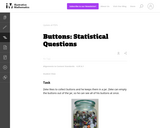
Statistics is the study of variability. Students who understand statistics need to be able to identify and pose questions that can be answered by data that vary. The purpose of this task is to provide questions related to a particular context (a jar of buttons) so that students can identify which are statistical questions. The task also provides students with an opportunity to write a statistical question that pertains to the context.

This is a task where it would be appropriate for students to use technology such as a graphing calculator or GeoGebra, making it a good candidate for students to engage in Standard for Mathematical Practice 5 Use appropriate tools strategically.

There are two aspects to fluency with division of multi-digit numbers: knowing when it should be applied, and knowing how to compute it. While this task is very straightforward, it represents the kind of problem that sixth graders should be able to recognize and solve relatively quickly.